Family Farm and Home 3 Ft Wire Fencing
- Planning the Fence
- Selecting the Fence
- Fencing Materials
- Structure
- Maintenance
- References

Fences may be used to protect or divide property, to improve its appearance, to confine animals, or to exclude animals. Whatever its purpose, one should plan a fence advisedly. This is especially important on farms where fences represent a large investment and their location and arrangement may affect product efficiency.
Permanent fences — those intended to last for many years with minimal repairs — should be well constructed and made of proficient materials. Temporary fences — those intended to stay in place only a short time — need not exist and so sturdily synthetic and may be made of less expensive materials. Whether you lot select permanent or temporary fencing, careful consideration of uses and proper maintenance is necessary.
Planning the Fence
Fencing is a long term investment. Practiced fences should final from 25 to 50 years. Planning is the central to expert fencing. This is true whether fencing an expanse for the outset time or replacing old, worn-out fences. If present fences are in skillful shape you may want to develop plans effectually them. Simply look alee to the solar day when these fences, too, may have to exist replaced. It is not wise to construct new divider fences if boundary fences are in disrepair and failing.
Sketch Map of Your Farm
The easiest mode to set a sketch of your farm is to start with an aerial photograph. A skillful aerial photo shows details of the present farm layout, plus some indications of the lay of the land. Aeriform photographs have been made of practically all farming areas. You tin can become one that includes your farm from the Farm Service Agency (formerly Agricultural Stabilization and Conservation Service) or your local tax office. Y'all tin can too obtain one from whatever commercial aerial survey business firm listed in the classified department of phone directories in major cities.
Add Land Capability to Map
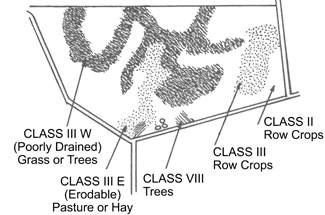 Figure i. A land capability map volition look something like this if prepared by the Natural Resources Conservation Service.
Figure i. A land capability map volition look something like this if prepared by the Natural Resources Conservation Service.
This pace may already exist complete if your state is in a Soil Conservation District. Land capability maps, bachelor from the Natural Resources Conservation Service (formerly Soil Conservation Service), generally evidence types of land and spell out use and management plans for the farm (Figure 1).
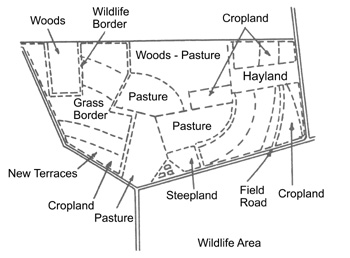 Effigy 2. Land capability layout.
Effigy 2. Land capability layout.
If an NRCS program is not bachelor for your farm, employ the sketch of your land which you previously obtained. Split up your land into areas that are best suited for: (ane) permanent pastures or hay production, (2) woodlands not to be pastured, (3) woodlands that can be pastured and (4) cultivated crop production (Figure 2). These land assignments are made based on uses that will return the greatest possible profit for each blazon of state.
Consider the post-obit points when developing your plan. If possible, locate fences in terraced fields at terrace's crest and other natural water divides. Avoid running your fences downward-gradient across terraces. If your field needs to be cross-fenced, effort to plan a contour debate parallel to a terraced ridge. If a fence must be located at the outlet end of a terrace, allow for a fence location that will not cake the outlet water movement from channels. Pastures located at the end of terraced land provide good grass receiving areas for excess water menses. Wherever possible, plan for straight fences; they are cheaper and easier to build.
Locating Lanes and Gates
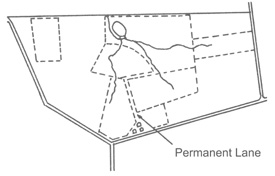 Figure 3. Locate permanent lanes to avoid erosion even so allow access to every bit many fields as possible.
Figure 3. Locate permanent lanes to avoid erosion even so allow access to every bit many fields as possible.
Ideally, a lane should connect livestock buildings and working pens with every field that somewhen may be pastured (Figure three). Keep in heed that a permanent pasture located betwixt other fields tin can be considered a lane itself.
Locate lanes in the driest areas possible, such as along a terrace or natural ridge; otherwise gullies may develop later repeated utilise. If a well-drained location is incommunicable, plan on movable lane fences which tin be relocated afterwards a year or 2. If lanes are used frequently, it may be desirable to course the area and install geotech fabric covered with 6 inches of compacted crusher-run gravel in the lane. Specifications for such "heavy use areas" tin exist institute at your local NRCS office. They can be installed for about one-half the toll of physical.
Wherever possible, locate gates and passageways for livestock and equipment in the corner of each field closest to farm buildings. If you have fields on opposite sides of a road or highway, locate gates opposite each other and so livestock can become directly beyond.
Locating Permanent Fences
First, a permanent contend around the farm boundary is highly desirable. This volition establish a fixed property line betwixt you and your neighbor. Information technology volition also help confine your livestock to protect both them and the driving public from possible highway collisions. If a fence around the entire purlieus is not affordable, then install the parts which are virtually helpful in your operations. Other boundary fences tin exist added at a later date.
Next, permanent pastures which volition be used yr after year besides deserve high priority in fencing plans. Programme to debate ponds, also, to control livestock access. Since these fences are not apt to be moved, programme for well built, low-maintenance construction. If the programme includes a lane that gives livestock access to water, this fence should also have high priority. Livestock may enter and harm a well managed timber stand up if there are gaps in surrounding fences. Such fences should take a loftier priority.
Besides consider permanent fencing for cultivated fields used for pasture. If you follow the practice of "hogging" corn or peanuts, or of turning your livestock into a field for "grazing downwards" after it has been harvested, a permanent argue is highly desirable. With careful study, temporary or movable fences such every bit electric fences may exercise the job economically and effectively around cultivated fields. However, movable fences usually don't final more than than three years and may not be economic replacements for permanent fences.
Locating Temporary Fences
Temporary fences are intended for use over a period of a few weeks or months. After that they volition exist removed and used in another location or stored until needed.
Movable fences cost less to build than permanent fences, but they are non as effective and will not last more than than 1 to iii years the style nearly of them are built. They practise not have the place of permanent fences, only tin be very beneficial in some instances.
Movable fences have a definite place in whatever livestock program. They can be used temporarily in identify of permanent fences until you can afford permanent fencing. They tin exist relocated from yr to year until you decide what field layout best fits your needs. They are easily moved to allow pastures to be rotated and are especially desirable for intensive rotational grazing programs. They can also assistance adjust the size of a temporary pasture to the amount of livestock beingness grazed.
Selecting the Fence
Now that you lot have your fencing programme laid out, your adjacent job will be to decide what kind of permanent or movable debate to select. The kinds of fences commonly used on farms include lath, barbed wire, woven wire, cable, mesh, high-tensile, electric or a combination of any of these.
The type of fence that yous volition demand depends on the livestock, crops, and other vegetation that edge the fence. Horses volition run through a fence or get tangled in information technology causing harm to themselves. Cattle will crawl over fences, sheep try to crawl under. Hogs, of grade, try to root their way under a fence. Whatever livestock volition put a contend to its greatest examination when there is a lush green crop on the opposite side.
Rail Fences
Rail fences are typically used every bit border fences around subcontract buildings or the home. They are too popular on equus caballus farms where expensive evidence animals are confined. Today, many choices are bachelor for edifice board fences including PVC plastic, vinyl coated wooden boards, treated forest, and painted forest. PVC plastic fences are not as strong as forest and cost more than, simply they are very attractive and do not require painting since they are the aforementioned color all through the material. White PVC boards may require periodic washing with mildew removing agents, specially in the humid South. Numerous heights of board fences are possible, but 4 to 5 feet are virtually mutual for livestock. The toll of lumber, nails, paint and other materials along with labor is more often than not higher for track fences than for most other fences.
One type of fence that has the appearance of a rail contend, only is actually a wire fence is called a high-tensile polymer debate. The "rails" consist of vinyl plastic four to half-dozen inches broad with 2 to three loftier-tensile steel wires encased. It is less expensive than a rail fence, is very stiff, and has a overnice appearance and good visibility, but the wires must be tightened once or twice per year to maintain the proper tension. (This is truthful of any high-tensile fence.)
Barbed Wire Fences
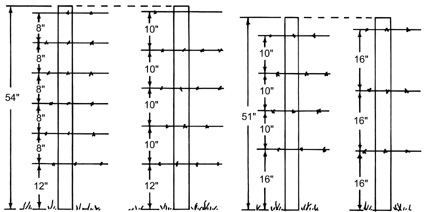 Figure 4. Mutual spacings of wire in barbed wire fences.
Figure 4. Mutual spacings of wire in barbed wire fences.
Barbed wire fences are generally classified in two categories: standard barbed wire fences and suspension barbed wire fences.
Standard barbed wire fences (Figure 4) ordinarily have posts spaced 10 to 12 feet apart and apply three to five strands of wire.
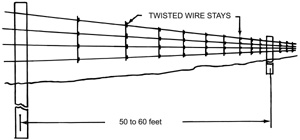 Figure 5. Typical spinous wire intermission fence.
Figure 5. Typical spinous wire intermission fence.
Suspension barbed wire fences (Figure 5) consist of four to six strands of spinous wire. Each strand is stretched taut so there is no more than 3 inches sag between posts. The suspended barbed wires are held autonomously past twisted wire stays or short pieces of fiberglass posts spaced approximately 10 to 12 feet apart. Line posts are spaced from l to sixty feet apart. The intermission spinous wire fence sways back and forth in the current of air or when animals hit it. The swaying motion helps keep animals away from the fence and discourages them from fighting through it. For this reason the lower end of the stays must not touch the ground or the effectiveness of the suspension fence will be reduced.
Woven Wire Fences
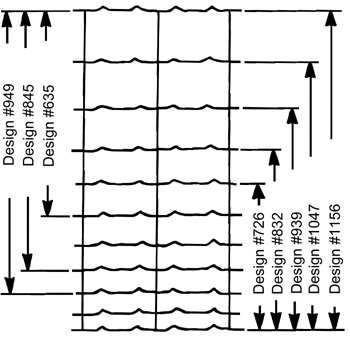 Figure half dozen. Some mutual woven wire designs. Standard pattern numbers describe the wire: 949-12-11, for instance, means the fence has 9 horizontal wires and is 49 inches high; has 12-inch spacing of stay (vertical) wires and 11-judge stay and intermediate wires. (Top and lesser wires are commonly two sizes larger.)
Figure half dozen. Some mutual woven wire designs. Standard pattern numbers describe the wire: 949-12-11, for instance, means the fence has 9 horizontal wires and is 49 inches high; has 12-inch spacing of stay (vertical) wires and 11-judge stay and intermediate wires. (Top and lesser wires are commonly two sizes larger.)
Woven wire fences consist of a number of horizontal lines of smooth wire held apart past vertical wires called stays. Spacing between horizontal line wires may vary from as close as 1.v inches at the bottom for small animals to 9 inches at the top for large animals. Spacing of the wires generally gets wider as the fence gets higher.
Stay wires are spaced 6 inches apart for small-scale animals and 12 inches for large animals. The height of most woven wire fencing materials ranges from 26 to 48 inches. The height needed will depend on the size and jumping ability of the animals. Many combinations of wire sizes and spacing as well every bit a number of fence heights are available. Standard woven wire argue designs are shown in Figure 6.
Cable Wire Fences
These fences usually consist of iii/8-inch smooth, steel wire cables stretched from i ballast post to another (Figure 7). Each cablevision is normally made out of vii strands of wire twisted together. Heavy springs are placed at one stop of each cable to absorb any shock on the wires. The other end is rigidly attached to the next ballast post. Cables are unremarkably passed through holes in wooden posts. If other kinds of line posts are used, cables are attached to them with heavy wires. A fence may have every bit many cables as desired, however, a six cable fence is common. Spacing between wires depends upon the kind of animal to exist confined. Cablevision wire fences are expensive, thus they are mostly used for confinement areas such equally holding pens, feed lots or corrals.
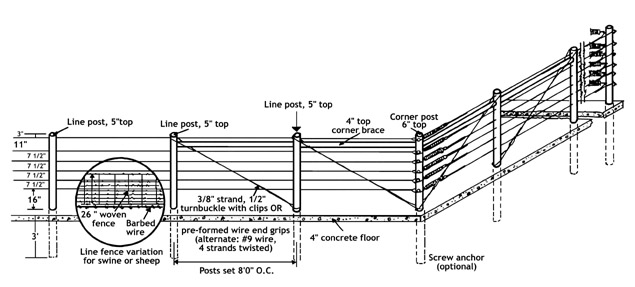 Figure 7. Cable fence — i type of installation.
Figure 7. Cable fence — i type of installation.
Mesh Wire Fences
 Figure 8. a) Detail of diamond-mesh contend; b)Stiff-stay, square-knot contend pattern.
Figure 8. a) Detail of diamond-mesh contend; b)Stiff-stay, square-knot contend pattern.
Mesh wire fences are potent and provide great safe to animals. They are replacing wood board fencing in many areas, merely are even more expensive than expert woven wire. Because of the cost they are used primarily for confinement fencing such as that effectually corrals, feed lots, or small crop acreage areas. They too make an first-class large area fence for valuable horses. They have modest openings and then horses don't tend to become their hooves caught in them, and they accept no exposed sharp wire ends to cut an creature. Ii types of mesh wire are the diamond mesh (Effigy 8a), which uses two wires twisted together in a diamond formation, and the square knot mesh (Figure 8b), which has unmarried horizontal lines with the wire spaced 2 to four inches apart.
Loftier-Tensile Wire Fences
Loftier-tensile wire fences potentially have longer life and lower costs than conventional fences. Single, smooth wires are held in tension between pressure-treated wood terminate-post assemblies with a combination of posts and battens or droppers to go along the wires properly spaced between posts. Tension in the wire is maintained past permanent in-line stretchers and tension springs. All-time results are achieved when tensioners are used in conjunction with springs. Wires must be attached to any intermediate posts in such a way that they can motility laterally and exist retensioned. Wires should exist retensioned at least once or twice per year. Commonly i to five or more strands of high-tensile wire are used in a fence. It is recommended that one or more than of the strands be electrified in society to prevent animals from scratching on the battens and thus moving them out of position. If this happens, it could result in long unsupported lengths of wires, allowing animals to get through the fence.
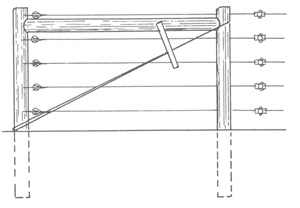 Effigy nine. Typical high-tensile debate caryatid and wire tensioner location.
Effigy nine. Typical high-tensile debate caryatid and wire tensioner location.
If properly designed and constructed, high-tensile smooth wire fencing has many advantages. It is easier to handle, safer for livestock, easily adjusted to specific needs, has longer life, requires petty maintenance, causes minimum damage to livestock hides, has a nifty appearance and gives better livestock restraint and predator control when electrified.
Figure 9 shows a typical five-wire high-tensile fence with in-line wire tensioners.
Electric Fences
Electrical fences can be built for temporary or permanent use. In add-on, a strand of electrified wire added to other types of fence usually improves their effectiveness tremendously. The temporary or movable fence is usually made with one or 2 strands of polish wire or a rope or tape with pocket-size electric wires woven into information technology. Tape or rope is more flexible than smooth wire and much easier to handle and move from one location to another. It is also more visible, an of import factor when a fence is to be moved periodically to new locations where livestock are non used to seeing it. An electric fence controller is used to energize the wires. The moist earth is used to allow the electric current to return to the controller. Alternatively, one strand of wire can exist grounded, then that the circuit can be completed even when the globe is very dry and thus a poor usher. Corners and stop posts in temporary electric fences require less bracing than permanent fencing. Line posts may be small-scale with wide spacing since the contend will mostly be used for a curt period of fourth dimension.
Permanent electrical fences may as well be built. These fences have from ii to eight smooth wires placed on stronger posts. Instead of using the globe for a return path, many electrical fences utilise alternating wires as the hot wire and the grounded return to the charger. This system enables a completed circuit when an animate being touches any two adjacent wires and improves the performance of the contend tremendously in drought conditions. Toll of permanent electrical fence is much less than that of comparable barbed or woven wire fences. Some of the advantages of electric fencing are low initial cost, low operating cost, and portability. They can be used to protect or extend the use of old permanent fences and they tin can exist used to protect livestock or poultry from many predators.
In that location are a few disadvantages, withal. A home-built unit of measurement can exist highly dangerous. Only approved contend chargers should be used. Livestock will crave grooming when first using electric fences. The electric argue charger must exist operated total time, especially with cattle and sheep. Also, if no return ground wires are used, electrical fences may not be effective in dry conditions. This is specially true if the controller is not well grounded. Another potential problem is that the charged wire may curt-circuit and become ineffective if heavy vegetation is allowed to contact the wires. It is imperative that electric fences exist inspected and that vegetation be controlled in order to minimize short circuiting. For this reason, an electric contend may not be a adept selection about wooded or swampy areas with heavy vegetative growth.
Comparison of Contend Types
Equally previously stated, the type of argue needed depends on livestock, border crops, predators and other factors including cost. Table 1 shows some full general comparisons for use when selecting a debate.
| Tabular array 1. Comparing of Common Fences | |||
| A. Permanent Types | |||
| Types | Comparative Price Index1 (Textile Only) | Approximate Life2 in Humid Climate (Years) | Upkeep |
| 4-Rail (Posts spaced 8 feet) | |||
| 1" x half dozen" Treated Boards | 200 | ten-20 | Medium |
| 2" ten 6" Treated Boards | 350 | ten-20 | Medium |
| PVC Rails | 500-600 | 20 | Low |
| Loftier-Tensile Polymer Coated | |||
| 5-inch rails width | 330 | 33 | Medium |
| Barbed-Wire Fencing (One mail service per 10 feet) | |||
| 5 strands | 35 | 33 | Loftier |
| Suspension Fencing (Posts 50 feet apart) | |||
| 5 strands | 25 | 33 | Medium |
| Woven Wire Fencing | |||
| 39-inch with ii strands barbed wire | 75 | 33 | Medium |
| Cable Fence | |||
| five cable (five') | 500 | xxx | Low |
| Mesh Wire | |||
| 12.5 cuff | 150 | 38 | Low |
| Permanent Electrical3 - (12.5 gage) and Loftier-Tensile Fences | |||
| 4 strands | 20 | 25 | Medium |
| B. Moveable Electric Fences 3 | |||
| Types | Comparative Price Index1 (Textile Just) | Guess Life2 in Boiling Climate (Years) | Upkeep |
| Steel Wire (Smoothen, ane-strand) | |||
| 12 gage | 7 | 33 | High |
| Cogitating Tape or Rope | |||
| 0.5-inch | 11 | 30+ | Medium |
| ane Price index figures are to show relative cost, non actual costs. For example, contend with an index figure 25 costs most twice as much per pes as a fence with an index effigy of 12. 2 Fence life based on combination of post and wire life expectancy. 3 Costs of electrical controller not included. | |||
Fencing Materials
Wire
Wire is covered with zinc, commonly chosen galvanizing, to protect it from rusting. The length of time before wire begins to rust depends on the conditions but besides on the thickness of the zinc coating. More zinc means more years of service before rusting starts. Fence manufacturers and the American Society for Testing Materials have established "classes" of zinc coatings for fence wire. Form one has the lightest coating of zinc and Class 3 has the heaviest (two to three times as much, depending on the wire size). The expected life of a debate depends on many factors, but Form 3 galvanizing can easily add together five to 10 years of life to fence wire in a boiling climate like Georgia's.
Because of competition, many suppliers of fencing materials simply stock Form 1 fencing or a limited number of products in Class three. Commonly, a light gauge Form 3 spinous wire is stocked along with a heavier judge Class 1 spinous wire since both of these products sell for about the same toll. Other products with Class iii galvanizing may accept to be special ordered, but it is normally worth the extra cost and endeavor, especially in the humid southeastern climate. If consumers demand a higher quality product, dealers will certainly supply that demand.
Staples
Selecting the appropriate staple is just as important to the overall force and longevity of the fence as selecting the right wire. Staple pull-out is a common fencing problem when using softwood posts. To avert this problem, use ane.75-inch or 2-inch long, viii- or 9-estimate, hot-dipped, galvanized staples with cut points and barbs. If using hardwood posts, shorter staples can be used because they cannot exist pulled out of hardwood as easily.
Debate Posts
Wooden posts are plentiful in Georgia. Some major advantages of wood posts are strength and resistance to angle, misalignment and withdrawal. Permanent fences volition require decay resistant debate posts. The nearly common wooden posts are pine pressure level treated with CCA (chromated copper arsenate.) These posts take a green colour, and they concluding longer and are harder than older treatments such as creosote and Penta (penta-chlorophenol.) This quality of hardness tends to help foreclose staples from being pulled out. Some native, untreated trees are still used to a limited extent for contend posts. Table 2 shows the life expectancy of different tree varieties when used as argue posts.
Wood posts from 5.v to 8.5 feet long and from 2.5 to eight inches or larger diameter are readily bachelor. The larger the superlative diameter, the stronger the mail service. Line posts can be as small equally 2.5 inches, but larger ones volition provide for a stronger, more durable contend. Corner and gate posts should have a top diameter of at to the lowest degree 8 inches. Brace posts should be 5 inches or more than in diameter.
Be careful when buying wooden posts that the posts are properly treated for contact with the soil. Virtually treated lumber (including 4-by-4s frequently used every bit posts) bought in builder's supply stores is treated at 0.25 lb of CCA per cubic foot of lumber. This level of handling volition not protect against termites. Sawn lumber should be treated at 0.v to 0.6 lb/ft3 of CCA if information technology is to be in contact with the earth. Debate posts can be treated at 0.4 lb/ft3. Many people are tempted to employ "landscape timbers" for argue posts considering they are extremely cheap at times due to over supply. These timbers are a byproduct of the plywood industry. They are what is left after the veneer has been peeled off of a big log. The danger in using these for debate posts is that many times they are non treated for ground contact since they are not designed to back up a load and sometimes are not labeled, so it is unclear what, if any, treatment has been applied.
Steel posts have 4 major advantages. They cost less, weigh less, tin be driven into the ground rather easily, and are fireproof. They also help ground the fence against lightning when the soil is moist. Steel posts vary from 5 to eight feet long. A wide variety of steel posts are available with widely varying prices and quality, so exist careful when comparing shopping to make sure you are comparing equal quality posts. Steel posts practice non have equally much strength against bending as wood posts. Wooden line posts tin can be placed every 50 to 75 feet to aid go on steel posts from bending and improve fence stability.
Various kinds of posts are available for electric debate line posts as the requirements for force are much less than for nonelectric fences. Posts are available in woods, plastic, steel, and fiberglass. Woods and steel posts require insulators to prevent short-circuiting the fence through the posts. Where available, loftier-density fiberglass posts (usually known as sucker rod) make first-class electric fence posts. These posts are byproducts of the oil industry and are not always available. They are usually gray in colour, are very strong and durable, and are nonconducting, and so insulators are not required.
All posts must exist long enough for the fence acme and depth of setting. Add together the height of the pinnacle wire above the footing, the depth of the post in the ground, and 6 extra inches to get the desired length.
| Table 2. Life Expectancy of Wood Argue Posts (in Years). | ||
| Type of Forest | Untreated | Treated |
| Ash | 3-7 | 10-15 |
| Aspen | two-3 | xv-xx |
| Bald Republic of cyprus | vii-15 | 20-25 |
| Balsam Fir | 4-half-dozen | 10-fifteen |
| Basswood | 2-3 | xv-20 |
| Beech | three-vii | fifteen |
| Birch | 2-iv | ten-20 |
| Black Locust | 20-25 | Not necessary |
| Box Elder | 2-7 | 15-20 |
| Butternut | 2-7 | fifteen-20 |
| Catalpa | 8-xiv | 20-25 |
| Cedar | 15-xx | 20-25 |
| Cotton Wood | ii-vi | 10-15 |
| Douglas Fir | 3-7 | xv-18 |
| Elm | 4 | 15 |
| Hackberry | 3-7 | 10-17 |
| Hemlock | 3-half-dozen | x-25 |
| Hickory | 5-vii | 15-20 |
| Honey Locust | 3-7 | ten-20 |
| Larch | iii-7 | 10-twenty |
| Maple | 2-4 | 15-20 |
| Oak (red) | 5 | 15 |
| Oak (white) | 10 | 15-twenty |
| Osage Orange | twenty-25 | Not necessary |
| Pine | three-7 | 25-30 |
| Red Cedar | 15-xx | 20-25 |
| Crimson Mulberry | 7-15 | xv-30 |
| Redwood | ten-xv | 20-xxx |
| Sassafras | 10-15 | twenty-25 |
| Bandbox | three-seven | 10-xx |
| Sweetbay | 2-6 | 10-xx |
| Sweetgum | iii-6 | 20-30 |
| Sycamore | 2-7 | 20-25 |
| Tamarack | seven-10 | 15-20 |
| Tupello (black) | 3-7 | 15-20 |
| Willow | 2-6 | 15-20 |
| Yellowish Poplar | 3-7 | 20-25 |
Electrical Argue Controllers
Most people will concord that touching an electric fence is a very unpleasant feel. The feel for animals is no different. When animals come up in contact with an electrical fence, the shock they receive affects their nervous systems. The severity of the stupor depends on the voltage and amperage, as well as the elapsing of the shock and the sensitivity of the animal. It takes at least 700 volts to finer control short-haired breeds of cattle, pigs, and horses and around 2000 volts for long-haired cattle, sheep, and goats. The controller, sometimes called the charger or energizer, that delivers this shock is the heart of any electrical fence and should exist selected carefully.
The thing that makes controllers safe yet effective is the curt duration of the charge. The accuse is powerful, yet does not concluding long enough to harm the heart or to cause electrical burns. Modern low-impedance controllers accept the capacity to power long distances of multi-wire fences and are not affected as much as before controllers past some contact with grass or other vegetation.
Controllers are available in battery powered models as well as 120-volt AC models. When 120-volt power is bachelor, the 120-volt models have the obvious advantage since batteries do non take to be purchased or recharged. Cost of functioning is minimal (commonly less than $ane per month) for these units. If commercial power is not bachelor near the fence to be energized, bombardment-powered units are available to fill this need. These units operate on 12, 24, or 36 volts (i, 2, or three 12-volt batteries in series). The batteries must be recharged every 2 to half-dozen weeks depending on the system and corporeality of use. Solar collectors are also available to recharge the batteries daily. Deep cycle, marine and RV type batteries are best suited for bombardment-operated controllers. Batteries designed for utilise in automobiles will not concluding as long as deep-bicycle batteries.
It is important to match the capacity of the controller to the fence you want to accuse. Well-nigh manufacturers indicate the strength of the unit of measurement by the number of miles it will power. A skillful rule of thumb for sizing controllers is to make up one's mind the number of miles of electrified wire in the fence and add 25 percent to commencement any power drain caused by vegetation touching the fence. For instance, if you have 4 miles of v-strand loftier-tensile wire with three of the strands electrified, y'all would demand a controller rated for at least 15 miles (three wires x 4 miles = 12 miles + 25% = 15 miles.)
Construction
Similar nigh structure and maintenance jobs around the farm, fence construction requires proper techniques and common-sense judgment. Every fencing task presents slightly different problems. A few basic principles are skilful starting points for every fencing job. Here are some to consider.
Establishing the Fence Line
Where a permanent argue is installed on a property line, make certain of the verbal location of property lines. A fault here can be very costly. Once this is done and any trees and brush are removed, you are prepare to plant the fence line.
On level ground, an end mail can exist installed at each cease of the run and a string or a single strand of wire stretched between the two posts to establish the line. On rolling basis where hills are as well high to sight from one cease-post to the next, surveying equipment can be used if available to found the location of intermediate points on the line. Alternatively, intermediate sighting stakes can exist driven at the tops of hills. Two of these temporary stakes should exist driven about eight to 10 feet autonomously at the approximate position where the line will cross the crest of the hill. If both posts announced to be lined upwardly when sighted from each end post, they represent a truthful midpoint of the line. If not, they can be moved back and forth until they are properly aligned.
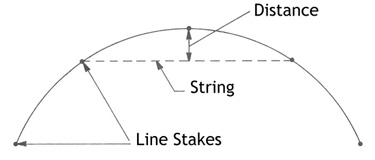 Figure ten. Fence post spacing around curves.
Figure ten. Fence post spacing around curves.
When the fence must go around a curve, place modest stakes every xvi feet around the smooth curve. Then get-go figuring the post hole positions where the curve is greatest. The sharper the curve, the closer the posts should exist. Select three stakes at a indicate of maximum curvature. String a line from the beginning to the tertiary stake (Effigy 10). Measure out the distance from the centre pale to the string, and space the posts as given in Table 3.
| Tabular array three. Suggested Fence Post Spacing Around Curves | |
| Distance from Center Pale to String (inches) | Post Spacing (anxiety) |
| eight or less | 12 |
| 8 to fourteen | ten |
| 14 to 20 | 8 |
End, Corner, and Gate Post Brace Assemblies
For any wire fence, corner-post and end-post assemblies are probably the most important structures in the entire fence. They are the foundation upon which the fence is congenital. When wire is first stretched, the pulling force on a corner or cease may exist 3000 pounds. Winter common cold tin can cause wrinkle of wire which increases that force to 4500 pounds. Both corner and finish assemblies must be stiff plenty to withstand these forces.
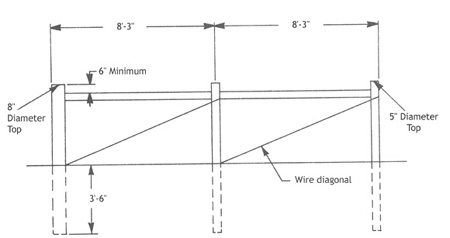 Effigy eleven. Double-bridge brace post assembly. Post depths shown are considered to be minimum.
Effigy eleven. Double-bridge brace post assembly. Post depths shown are considered to be minimum.
Figure 11 shows proper construction of a double span H-brace associates for wooden anchor posts. A double span assembly is more than than twice every bit strong equally a single bridge; employ it whenever the argue span will be more than 200 feet long. A corner post will need a caryatid associates for each argue line leading to it. Post depths shown in Figure 11 are minimums. Use deeper settings for sand or wet soil weather condition. Figure 12 shows the proper way to secure brace wire.
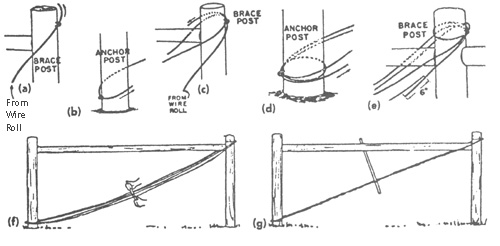 Figure 12. Correct procedure for threading the nine gauge shine wire used as diagonal in the caryatid assembly.
Figure 12. Correct procedure for threading the nine gauge shine wire used as diagonal in the caryatid assembly.
When a debate is more than 650 feet between corner posts, use braced line post assemblies every 650 feet in the fence line. A braced line associates is the aforementioned as a unmarried span braced corner except that a 2nd diagonal brace wire is used to have fence pull in the opposite management.
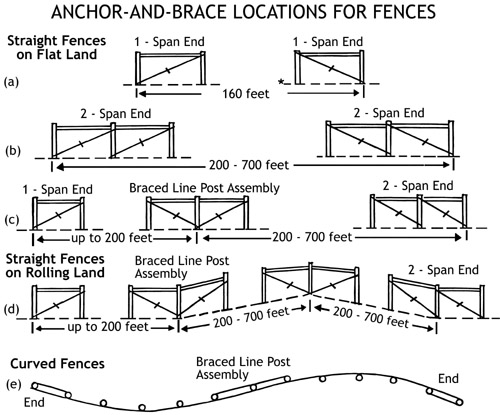 Figure 13. Types of ballast-and-brace assemblies and where to locate them. (a) For contend lengths of 160 feet or less, employ single-bridge end structure. (b) For fence lengths of 200 to 700 feet, use double-span finish construction. (c) For fences more than 700 anxiety long, use a brace-line-post associates to divide the debate lengths. (d) On rolling country, fence stretching is easier if braced line-post assemblies are located at the foot and peak of each hill. (e) Contour fences, more than than 350 feet long, should have a braced-line-post associates installed to proceed the stretches to 350 feet or less. Install in straight department at least one post span away from a curve. Don't install on a bend; information technology won't hold well.
Figure 13. Types of ballast-and-brace assemblies and where to locate them. (a) For contend lengths of 160 feet or less, employ single-bridge end structure. (b) For fence lengths of 200 to 700 feet, use double-span finish construction. (c) For fences more than 700 anxiety long, use a brace-line-post associates to divide the debate lengths. (d) On rolling country, fence stretching is easier if braced line-post assemblies are located at the foot and peak of each hill. (e) Contour fences, more than than 350 feet long, should have a braced-line-post associates installed to proceed the stretches to 350 feet or less. Install in straight department at least one post span away from a curve. Don't install on a bend; information technology won't hold well.
Effigy 13 illustrates ballast and brace locations for fences. Steel corner post and brace assemblies can be used in place of forest assemblies. The steel posts should be set in concrete anchors. Corner postal service anchors should be twenty inches foursquare and 3.5 feet deep. Braces are anchored in twenty-square-inch blocks that are ii feet deep.
In that location are some other brace assemblies that are not as potent every bit the H-brace, but will work in many cases for short pulls and in favorable soil conditions. One is normally called a "expressionless man" caryatid (Figure xiv). The end post should be a large (10-12") mail service at least 4 anxiety in the ground. The "dead man" is a brusque (4 pes) slice of post cached merely under the surface perpendicular to the cease post on the loaded side. This positioning supports the post such that when the post tries to lean, it must button the "dead man" through the soil sideways.
 Figure 14. "Dead Human" brace.
Figure 14. "Dead Human" brace.
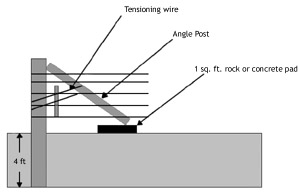 Figure 15. Angle brace.
Figure 15. Angle brace.
A 2nd blazon of caryatid, chosen an angle brace, is shown in Figure 15. The keys to making this brace work are (1) making sure the end mail is deep in the ground (nearly iv feet), (ii) placing a 1 to ii square foot rock or slice of physical under the angle brace mail, and (three) properly tensioning the tension wire. It is the tension wire that gives this brace its force, not the angle post. If the contend starts to sag, it tin usually be tightened by retensioning the tension wire.
Contend Postal service Setting
Steel posts are almost always manus or power driven. Woods posts are frequently driven with power driving equipment. Driving posts is faster than excavation holes and tamping posts in. Driving besides results in a stronger foundation for the post. Posts should be driven with the small finish downwardly. The results may expect strange (large end up), but they are much stronger and damage to the post during driving is minimized. Corner posts tin be driven every bit well, simply it is sometimes necessary and e'er advisable to drill a pilot hole well-nigh 3 to iv inches smaller than the mail before driving. The pilot hole reduces driving resistance and gives more than control over the management of lean of the mail service. (End posts should exist driven at a slight angle away from the direction of pull and then that they volition be straight when tensioned.)
When setting posts in holes, heart them before tamping. This makes tamping easier and gives the tightest possible soil-pack around the post. Wooden line posts should be gear up at least 2 anxiety deep, preferably deeper. In most soils, studded "T" posts demand to be driven merely until the anchor plate is beneath the surface. For uniform depth, mark the earthworks tool or steel post to desired depth. A guess pole, cut to desired length, is handy for spacing posts. Space line posts about 10 to 12 feet apart for most fences. Narrow spacings are improve over irregular ground and in contour fences.
Installing Wire on Fences
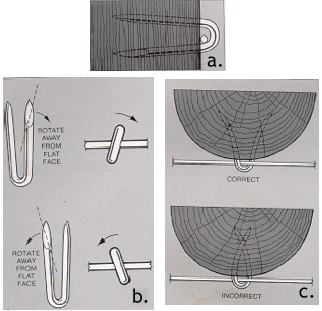 Figure 16. Proper stapling techniques.
Figure 16. Proper stapling techniques.
In general yous will desire to install and stretch wire in sections, running from one corner and/or caryatid mail assembly to the next. Ever work from the lesser up when installing wire. Install the bottom wire beginning, and so the adjacent highest, etc. Adhere wire to the side of the post nearest livestock except where advent is important. Use galvanized staples or the wire clips that come up with steel posts to attach wire to posts. Staples should never be smaller than 1.5 inches long, preferably 1.75 or two inches. Exercise non staple the vertical or stay wires of woven wire. Bulldoze staples so the wire is held shut to the mail service but not tight (Effigy 16a). The wire should be able to move through the staple to allow expansion and wrinkle of the wire. Good brace assemblies should keep the wire tight. Driving staples parallel with the grain should be avoided since that will weaken the grip of the wood on the staple. Slash cut staples should exist rotated in a certain direction depending on whether the staples are correct or left cutting (see Figure 16b). Place the staples parallel to the grain and then rotate slightly away from the flat faces of the staple points. This will result in the desired management of staple penetration (Effigy 16c) and a staple that has xl percent more resistance to withdrawal than staples rotated the wrong way.
Electric Fence Controllers
One of the best ways of assuring good functioning of a debate controller is to provide a skilful grounding system. The controller grounding arrangement should be separate (at least 30 anxiety away) from whatever other driven grounds. Failure to do this could cause devious voltage issues on the farm electrical arrangement. The grounding system should consist of at least 24 anxiety (usually iii 8-foot driven rods spaced half-dozen feet autonomously) of basis rod. In addition, a driven ground rod should exist placed every 3000 feet (1500 anxiety in arid climates) of contend and attached to the grounded wires in the debate. Proper grounding will brand the task of the charger easier and thus ameliorate its performance. Lightning arresters are available and assistance protect the controller if the lightning strike is not too close, but will probably not prevent harm past a direct hit. Making the top wire on the contend a grounded wire sometimes helps protect the controller past shunting lightning to the basis instead of through the controller.
Gates and Cattleguards
Y'all tin can buy or build gates or cattle guards. Both should exist sturdily built and adequately supported. I of the most common (and aggravating) mistakes made when building fences is inadequate bracing of gates which results in gates dragging on the ground. Several plans for gates, man passages and cattle guards are available through your local canton extension office.
Maintenance
A fence that is properly cared for will give long and problem-costless service. Include some of the following suggestions in your regular maintenance program:
- Repair or replace anchor mail service assemblies when-ever they show signs of weakness.
- Refasten loose wires to posts and splice broken wires when necessary.
- Keep the fence wires properly stretched. This will exist needed once or twice per year for loftier-tensile fences.
- Keep weeds and brush cleared from the fence line, especially on electric fences.
- Program and follow a regular inspection routine for whatever needed maintenance.
References
Planning Fences, American Association of Vocational Instructional Materials, 1980.
Planning & Building Fences on the Subcontract, University of Tennessee Agricultural Extension Service Pb 1541, 1996.
Status and Revision History
Published on Feb 01, 2000
Published on February 20, 2009
Published on May 14, 2009
Published with Full Review on February 16, 2012
Published with Full Review on Feb 20, 2015
Source: https://extension.uga.edu/publications/detail.html?number=C774&title=Fences%20for%20the%20Farm
0 Response to "Family Farm and Home 3 Ft Wire Fencing"
Post a Comment